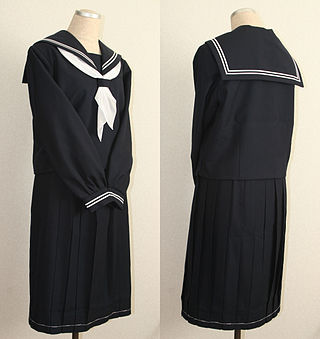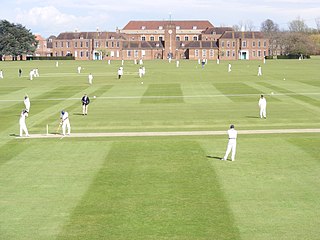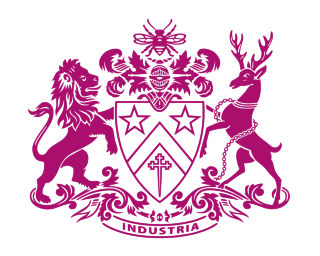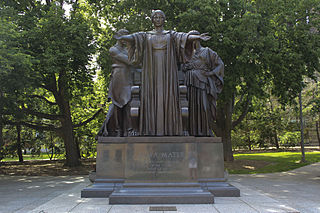
A uniform is a variety of costume worn by members of an organization while usually participating in that organization's activity. Modern uniforms are most often worn by armed forces and paramilitary organizations such as police, emergency services, security guards, in some workplaces and schools, and by inmates in prisons. In some countries, some other officials also wear uniforms in their duties; such is the case of the Commissioned Corps of the United States Public Health Service or the French prefects. For some organizations, such as police, it may be illegal for non-members to wear the uniform.

Eton College is a public school in Eton, Berkshire, England. It was founded in 1440 by Henry VI under the name Kynge's College of Our Ladye of Eton besyde Windesore, making it the 18th-oldest school in the Headmasters' and Headmistresses' Conference (HMC). Originally intended as a sister institution to King's College, Cambridge, Eton is known for its history, wealth, and notable alumni, known as Old Etonians.

The Japanese school uniform is modeled in appearance similar to that of the European-style naval uniforms. It was first used in Japan in the late 19th century, replacing the traditional kimono. Today, school uniforms are common in many of the Japanese public and private school systems. The Japanese word for this type of uniform is seifuku (制服).
An old boy network is an informal system in which wealthy men with similar social or educational background help each other in business or personal matters. The term originally referred to social and business connections among former pupils of male-only elite schools, though the term is now also used to refer to any closed system of relationships that restrict opportunities to within the group. The term originated from much of the British upper-class having attended certain fee-charging public schools as boys, thus former pupils are "old boys".

Charterhouse is a public school in Godalming, Surrey, England. Originally founded by Thomas Sutton in 1611 on the site of the old Carthusian monastery in Charterhouse Square, Smithfield, London, it educates over 800 pupils, aged 13 to 18 years. Charterhouse is one of the original nine English public schools reported upon by the Clarendon Commission in 1864 leading to its regulation by the Public Schools Act 1868.

Private schools in the United Kingdom are schools that require fees for admission and enrollment. Some have financial endowments, most are governed by a board of governors, and are owned by a mixture of corporations, trusts and private individuals. They are independent of many of the regulations and conditions that apply to state-funded schools. For example, the schools do not have to follow the National Curriculum, although many such schools do.

Fettes College is a co-educational private boarding and day school in Craigleith, Edinburgh, Scotland, with over two-thirds of its pupils in residence on campus. The school was originally a boarding school for boys only and became co-ed in 1983. In 1978 the College had a nine-hole golf course, an ice-skating rink used in winter for ice hockey and in summer as an outdoor swimming pool, a cross-country running track and a rifle shooting range within the forested 300-acre grounds. Fettes is sometimes referred to as a public school, although that term was traditionally used in Scotland for state schools. The school was founded with a bequest of Sir William Fettes in 1870 and started admitting girls in 1970. It follows the English rather than the Scottish education system and has nine houses. The main building, called the Bryce Building, was designed by David Bryce.

A dress code is a set of rules, often written, with regard to what clothing groups of people must wear. Dress codes are created out of social perceptions and norms, and vary based on purpose, circumstances, and occasions. Different societies and cultures are likely to have different dress codes, Western dress codes being a prominent example.

The house system is a traditional feature of schools in the United Kingdom. The practice has since spread to Commonwealth countries. The school is divided into units called "houses" and each student is allocated to one house at the moment of enrollment. Houses may compete with one another at sports and maybe in other ways, thus providing a focus for group loyalty.
Bishop Douglass Catholic School is a Roman Catholic co-educational secondary school and sixth form, situated in East Finchley area of the London Borough of Barnet, England. Its current Headmaster is Martin Tissot, a former pupil at the school.

A pinafore is a sleeveless garment worn as an apron.

Queen Elizabeth's Hospital is a 7–18 independent boys day school in Clifton, Bristol, England, founded in 1586. QEH is named after its original patron, Queen Elizabeth I. Known traditionally as "The City School", Queen Elizabeth's Hospital was founded by the will of affluent soap merchant John Carr in 1586, gaining its first royal charter in 1590.
The South African College Schools is a public English medium primary and high education institution situated in Newlands - part of the Southern Suburbs region of Cape Town in the Western Cape province of South Africa. Founded in 1829, it is the oldest continuously run school in South Africa.

St Ambrose College is a Christian Brothers' Roman Catholic boys' grammar school in Hale Barns, Altrincham, Greater Manchester, England. It was founded in 1946 by Joseph Robertson. In 2012 the school became an academy, and was completely re-built. Upon leaving the college, boys are referred to as ‘Old Ambrosians’ and many go on to join the Old Boys' Association.

This article describes some of the unique features of Stonyhurst College, a Jesuit school in Lancashire, England.

Alumni are former students or graduates of a school, college, or university. The feminine plural alumnae is sometimes used for groups of women, and alums or alumns as gender-neutral alternatives. The word comes from Latin, meaning nurslings, pupils or foster children, derived from alere "to nourish".

In England and Wales, a public school is a type of fee-charging private school originally for older boys. They are "public" in the sense of being open to pupils irrespective of locality, denomination or paternal trade or profession; nor are they run for the profit of a private owner.

School uniforms in England are worn in over 90% of primary and secondary schools in England. Parents are required to purchase the uniform which in 2015 averaged roughly £212.88 per child.
Duke's Aldridge Academy is a co-educational secondary school located in the Northumberland Park ward of Tottenham in the London Borough of Haringey, United Kingdom.

School uniform is a practice that dates to the 16th century in England. Charity schools such Christ's Hospital, founded in 1552 in London, were among the first schools to use a uniform for their students. The earliest documented proof of institutionalised use of a standard academic dress dates back to 1222 when the Archbishop of Canterbury ordered wearing of the cappa clausa.

















